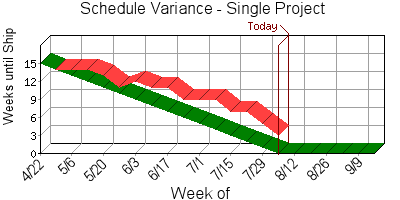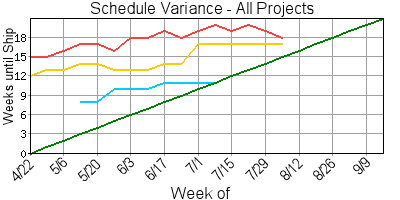
Legend:
Current schedule
Planned schedule
Schedules are about planning, tracking, and coordinating. They get heavy attention in the beginning of a project for planning. Then the schedules' details fade in importance. But schedules represent the use of critical company assets. These assets, primarily the staff, do not fade in importance. They actually grow in importance as experience accumulates with the specific project and with the company. The coordination of the assets across concurrent projects and with future projects becomes more essential in the later project phases.
The often forgotten tracking and coordination aspects of schedules are essential. More importantly, they are easy. An entire project team can and will assist with the coordination and tracking when the scheduling effort is visible to everyone.
Does every project team member know the expected schedule and how the project is tracking to that schedule today?

Legend: Current schedule Planned schedule |
In the above graph, a project's estimated "weeks until completion" (the red line) is updated weekly during development, and compared to the ideal project schedule (the straight green line).
This simple two line graph clearly declares that total project delivery is what benefits the company. A detailed schedule with a maze of tasks and milestones works to hide this key message. Again, the benefit to the company is in shipping the product. At a glace, senior managers and staff developers alike can see how the whole project (the red line), as well as just last week's effort (the ending slope of the red line), are contributing to the goal.
How do your projects achieve shipment: methodical effort, or chaotic and heroic efforts?
The software industry has a mythical romance with the "last minute push". It is truly a blind romance that remembers the special effort and camaraderie, but neither the underwhelming caliber of the final product nor the late delivery. Even senior managers seem to forget how the last minute effort meant a failure to meet customer and board member expectations.
It takes an entire team to return a slipped schedule back to plan. The sooner everyone is aware of a variance, the more time that is available for finding alternatives. With a public schedule variance graph, like the one above, the need for alternatives is reiterated early and often. The entire team has the opportunity to bring the schedule back to expectations early through suggested changes to the plan and / or several weeks of "a little more effort".
Besides, no "last minute push" can correct a project that is already overdue.
Is the team leader organizing the team, or is the team organizing the leader?
Team meetings occur for any combination of these three reasons: social interaction, problem resolution, and organizing the leader. The first two are essential to a project. The last is a poor use of time. A meeting to organize the team leader is one where each member's attendance is primarily required for delivering status.
Engineering status meetings last one or more hours, one to five times a week. A sample seven person team that meets 3 mornings a week spends 21 team hours preparing status. Only 8 team hours are spent if each person spent 15 minutes each morning planning their day and writing status bullets in an email.
Time management courses teach this very approach to sales representatives, accounting clerks, and engineering managers alike. Start each day by taking 5 to 15 minutes to think of all the current tasks, write them down, and prioritize them. For the team's benefit, each person should send the leader a paragraph, or set of bullets, as to what was done the day before and what is the priority list for today. The team leader updates the schedule status from these notes. The schedule variance graph is the feedback to the team members that their information was used.
Are all project teams and functional departments aware of every other project's current progress so that each can better anticipate needs and problems in coordination?

Legend: Project Gamma Project Beta Project Alpha (shipped) |
Each project's estimated "weeks until completion" is updated during the calendar period. Properly performing projects are represented by horizontal project lines. Time until project completion is the distance between the current project line and its projected intersection with the diagonal line. Schedule slippage is an upward shifting project line. These upward shifting projects need special review.
Any given manager is typically focused on their project or department. They rarely have the time to read detail reports from every project every week. This multiple project graph gives a quick summary of every project. Managers can spot the variances and focus their attention on alternatives.
Are you surprised by schedule slips?
Do projects "go dark" for major times between milestones?
Ever thought: "If I had only known sooner."
A project leader should be able to write an updated status report at any moment that contains three items: key dates compared to planned, red flag issues, and current bug count. This basic information takes less than 10 minutes to pop into an email. It can be scanned by management and peers quickly. Any detail concerns or clarification should be requested, not expected. This policy keeps the emails short and manageable.
Do managers' meetings focus on the expected project status or on the unexpected?
Weekly managers' meetings commonly have each manager say words about their project's accomplishments and issues. Often the managers, who are key company resources, spend the majority of this time just being an audience. Using the above graph and a list of any red flag issues, the meeting starts with the unexpected, the variances. This puts the full resources of the entire room were they can most benefit the company: getting all the projects shipping in a timely and coordinated manner. ... If time remains, discuss the expected.
Copyright 2002 On-Fire Associates. All rights reserved.